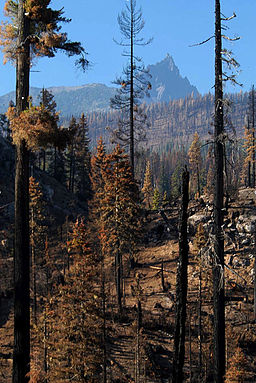By Katrina Marland
When you think of protecting a habitat for an animal, you probably think of a place that is green and full of life. A forest, a jungle, a grassland or others. What you probably don’t think of — and what I didn’t either, until recently — are the blackened remains of a post-fire forest. This razed landscape with its charred trees doesn’t look like it could support much life. But contrary to what we might think, this post-fire landscape is a habitat in its own right, not only capable of supporting life, but in the case of the black-backed woodpecker, vital to it.
When a forest burns, the trees become susceptible to a variety of pests, including wood-boring beetles that burrow into the bark to lay their eggs. The black-backed woodpeckers feed on these insects and their larvae — so where we see a forest laid to waste, they see a smorgasbord. When nature takes its course, fires occur every so often in a forest, burning enough to create this type of habitat and support it for a few years. By the time a forest recovers enough to no longer play host to the woodpeckers’ food, another fire would have already taken place somewhere within their range. The problem that the woodpecker faces now is that nature hasn’t taken its course in quite some time.
About a century of fire suppression has thrown the natural cycles of fire in those forests out of whack. Instead of frequent, low-intensity burns, fires are becoming fewer and farther between, but often more intense. This means that there is a smaller amount of this bird’s habitat — the post-fire forest — to begin with. The other side of the problem is that where the habitat does exist, it doesn’t remain untouched for very long. Today, when a fire occurs, humans are swarming the forest before the flames go out. After the smoke clears, crews use the damaged forest for salvage logging, taking down the trees that the insects — and in turn, the woodpeckers — rely on.
Although the black-backed woodpecker has been a native to North America since the last ice age, there are very few left in the U.S. today. Scientists estimate that only 1,000 pairs of the bird remain in Oregon and California, and less than 500 pairs are left in the Black Hills region of Wyoming and South Dakota. With numbers like that, things look pretty bleak for the black-backed woodpecker. That’s why several conservation groups have filed a petition to have the bird listed under the Endangered Species Act in their historic range across the Sierra Nevada Mountains, Oregon’s eastern Cascades and the Black Hills region. The petition marks the very first time that the federal government has been asked to recognize and grant protection to a post-fire habitat.
If the bird is deemed endangered, and its habitat protected, it could have some fairly widespread impacts. Some areas traditionally open to salvage logging after fires would be closed, which could affect local economies. At the same time, the birds could also put a real dent in the spreading population of one of their favorite snacks: the mountain pine beetle, which has caused no end of devastation in western U.S. forests. When infested stands are used for logging, the trees are removed, but this practice hasn’t resulted in much of a decrease in beetles. Since the birds feed on the beetles’ larvae, they could act as natural bug-fighters, if given the chance.
The U.S. Fish and Wildlife Service has a few months to determine if the black-backed woodpecker warrants an endangered listing. With so many other factors tied up in the fate of this one bird, and other post-fire-habitat-dependent species waiting in line to see what decision is made, it will be interesting to see if the powers that be will continue to see scorched forests as habitats that have been destroyed, or recognize them as distinct and valuable habitats in their own right.

